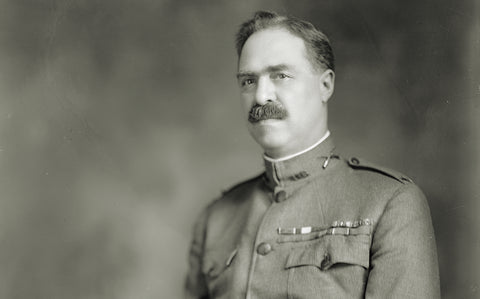
How ‘Gatling Gun’ Parker Earned Four Distinguished Service Crosses
He was famed among his U.S. Army colleagues and in the press as “Gatling Gun Parker.” John Henry Parker acquired that sobriquet during the Spanish- American War, when as a young first lieutenant he commanded a detachment of three Gatling guns that laid down withering fire support for the U.S. forces that stormed San Juan Heights in Cuba. Firing 18,000 rounds in less than nine minutes, Parker’s gunners killed many of the defenders and suppressed their fire. It marked the first instance in Army history in which machine guns supported infantry in the attack. For his actions on July 1, 1898, Parker received the Silver Star. Then Colonel Theodore Roosevelt, who 103 years after the fact was awarded a posthumous Medal of Honor for having led his Rough Riders from horseback up Kettle Hill, noted, “Parker deserved rather more credit than any other one man in the entire [Santiago] campaign.”
By the time of the U.S. entry into World War I Lt. Col. Parker had become the Army’s acknowledged expert in the organization, training and tactics of dismounted machine-gun detachments. He was a member of the staff of the American Expeditionary Forces that sailed for England with Maj. Gen. John J. Pershing aboard RMS Baltic in late May 1917. Sent ahead to the Army Machine Gun School in Langres, France, Parker trained young AEF soldiers on the still relatively new weapon.
Distinguished Service Crosses
Loath to sit out the war in the rear, 51-year-old Parker pushed successfully for assignment to a frontline unit. On April 20, 1918, the colonel was commanding the 26th (Yankee) Division’s 102nd Infantry Regiment when the unit came under German attack at Seicheprey, a supposedly quiet section where green American units were sent to gain experience. In one of the AEF’s first major engagements of the war the Americans suffered some 650 casualties and more than 100 men captured. In the midst of the enemy barrage Parker coolly moved forward to inspect his lines and command the defense. For his actions he was among the first members of the AEF to receive the Distinguished Service Cross—second only to the Medal of Honor for heroism in combat.
Two months later the 26th Division was committed as part of General Jean Degoutte’s French Sixth Army during the massive French counterattack into the Marne salient. Near Trugny on July 21 Parker, who remained in command of the 102nd Infantry, advanced on horseback through heavy enemy artillery and machine-gun fire. Preceding the lead elements of his own troops, he reconnoitered the German positions and the most advantageous avenues of approach for his attacking force. He received his second DSC for that action.
GET HISTORY 'S GREATEST TALES—RIGHT IN YOUR INBOX
Subscribe to our HistoryNet Now! newsletter for the best of the past, delivered every Wednesday.
Close
Thank you for subscribing!
Submit
Four days later Parker earned his third DSC while the division was advancing along the road through La Fére Wood. A battalion to his front was halted in the road, awaiting orders, when caught by an enemy artillery barrage with no cover but the shallow roadside ditches. “Immediately appreciating the situation,” read Parker’s DSC citation, the colonel “twice rode down the line and back again at a slow walk, stopping to talk with the men; and thus by his fearless personal exposure to, and disregard of, danger, he promptly steadied the troops and prevented probable disorder at an important juncture.”
By the start of the Allies’ costly Meuse-Argonne campaign on September 26 Parker was in command of the 91st Division’s 362nd Infantry Regiment. During the attack on the village of Gesnes three days later he again led from the front through heavy German machine-gun and artillery fire, including gas, shrapnel and high-explosive shells. Though twice wounded, he remained in command another five hours. Hit a third time, he tumbled into a crater full of other wounded soldiers. The following morning the colonel crawled from the crater and led his surviving men to the rear. While the war was over for Parker, the action at Gesnes brought him his fourth Distinguished Service Cross. He was the only foot soldier of World War I to earn four DSCs.
This story appeared in the 2023 Spring issue of Military History magazine.
historynet magazines
Our 9 best-selling history titles feature in-depth storytelling and iconic imagery to engage and inform on the people, the wars, and the events that shaped America and the world.
